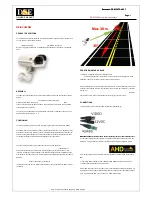
193
Alvium USB Cameras User Guide V3.3.0
Performance and troubleshooting
Dark current compensation
All sensors accumulate dark current in the pixels. Dark current increases the signal
level and black level. Most sensors in Alvium USB cameras compensate for this.
For
Alvium 1800 U-050m/c
with the ON Semi PYTHON 480 sensor, see
compensation for 1800 U-050m/c
If cameras are operated at high temperatures or long exposure times,
compensation reaches its limits. The typical compensation mechanism uses a
margin
to compensate for dark current. This works only until dark current reaches
the size of the margin. The following table shows the relation of the margin and
accumulated dark current for a pixel in 8-bit mode with a maximum value of 255.
Effective signal versus noise
Description
The pixel has accumulated no dark current, the margin has
maximum size.
The pixel has accumulated some dark current, reducing the size
of the margin.
The following images show a pixel that has accumulated a higher dark current than the margin.
The pixel has accumulated dark current, the margin reduces to 0.
Type 1 compensation
•
Dark current compensation is stopped.
•
Dark current increases the black level.
•
Fixed pattern noise increases.
The pixel has accumulated dark current, the margin reduces to 0.
Type 2 compensation
(Typically used for sensor-internal compensation, often in the
analog domain.)
•
Dark current compensation stays active.
•
Maximum saturation signal decreases.
•
Fixed pattern noise increases.
Table 94: Accumulated dark current affecting the effective image signal
Effective
image
signal
Margin
Saturation = 255
Black level = 0
Effective
image
signal
Accumulated
Dark
Current
Margin
Saturation = 255
Black level = 0
Effective
image
signal
Accumulated
Dark
Current
Saturation = 255
0
Black level > 0
Effective
image
signal
Accumulated
Dark
Current
Saturation < 255
Black level = 0














































